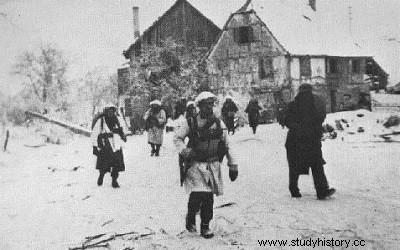
But the commander of the 2nd army corps still believes it is possible to break up the enemy front. He still hopes to breach the line on which the Germans intend to stop us all winter:the Winterline. He therefore decided to seize the eastern ridges of the Moselotte as quickly as possible, then to exploit in the direction of Rainkopf, Grand-Ventron and Drumont.
In addition, the assault will be given to the Château-Lambert - Le Thillot position, where the enemy had entrenched themselves.
Now covering up against Gérardmer, the 3rd D.I.A., reinforced by the 6th R.T.M., will act on the Tête-des-Cerfs - Haut-du-Faing Rainkopf axis, while the 1st D.B., with the 1st R.C.P. and the African commando group, will engage towards Travexin-Ventron-Oderen and the Thur valley.
On October 16, to open the Bresse road to armored vehicles, the 6th R.T.M. Colonel Baillif starts at the head of Cornimont on the Haut du Faing, an elongated hillock crowned with thick woods which, from its 1,003 meters, command the upper Moselotte, Bresse and Xoulces. It is flanked to the north by the 2nd G.T.M. of Colonel de Latour, to the south by the 3rd R.T.A. of Colonel Agostini. Simultaneously, the shock infantry of the 1st D.B. attacked on both sides of the Ventron valley.
Once again the rain fell in torrents. However, the Moroccans managed to reach the summit of Haut-du-Faing, the commandos captured Haut-du-Tonteux and the paratroopers climbed hill 1011. On the other hand, the 4th R.T.T. was nailed to its starting positions at Tête-du-Rondfaing.
On the 17th, the 6th R.T.M. completes the conquest of Haut-du-Faing. But in the valleys, the Germans do not yield an inch. Moreover, momentarily surprised by this new forehand, they were quick to pull themselves together. They bring in all their available reserves, including two battalions of political prisoners eager to redeem themselves and who, the day before the day before, were still in Karlsruhe. Everywhere the adversary orders the counter-attack which, everywhere, fails. But never before has the clash been bloodier. If a single German battalion left 70% of its strength on the slopes, the 6th R.T.M., whose capture of Haut-du-Faing cost a hundred men, left under the shredded fir trees of this ridge 700 killed and wounded to keep it. Because the German artillery has been reinforced and its fire in the woods is particularly deadly for troops who, stopped in their attack, have not yet had time to build covered shelters. And in the woods of Haut-du-Tonteux, the group of African commandos left 92 dead.
In the presence of this situation, despite the so dearly paid rupture of the In Haut-du-Faing, General de Lattre decided to halt the 2nd Corps offensive and to withdraw most of the means at its disposal as soon as possible. The Battle of the Vosges, as a determining element of the decision, is over. It had the result of fixing on our front 55,000 combatants supported by more than 25 artillery groups reinforced with numerous self-propelled and anti-tank guns. The German reinforcement in front of the 2nd C.A. was mainly to the detriment of the Montbéliard region. This results in the possibility of giving the enemy a new thrust by unexpectedly postponing our effort in this region. General de Lattre therefore decided to attempt a disruptive action there, entrusted to the 1st C.A., an action now made possible by the constitution of essential ammunition stocks. The 1st C.A. will be reinforced by the 5th D.B. and a large artillery.
To ensure surprise, the 2nd C.A. receives the mission to keep its defensive character clearly aggressive in order to maintain the enemy in his conviction that we persist in seeking the decision by the mountain. Indeed, the German command expects an imminent resumption of our offensive in the Vosges. While we withdrew the 1st D.B., the Pommiès franc corps and the Alsace-Lorraine brigade which passed into army reserve, he launched against the 3rd D.I.A. a fresh division called from Norway, the 269th. The assault of this division north of Bresse will be broken under the converging fires of two divisional artillery, before the departure of the A.D. towards the Belfort front.
At the same time, the Seventh U.S. Army asked us to cover on its right the offensive it was preparing towards Strasbourg. The conquest of the heights of Roches-son, to the left of our front, meets this goal. On November 3, this attack, entrusted to the 3rd D.I.A. Reinforced by various elements, including Commander de Sairigné's first foreign legion battalion, taken from the Ir' D.F.L., came up against violent opposition everywhere. Really the enemy considers the Vosges sector as the essential sector. Its 198th and 269th divisions oppose us with a compact barrage that it takes forty-eight hours of furious fighting to break down. But, on November 5, our objectives were achieved or even exceeded everywhere. We hold Rochesson, Menaurupt and the neighboring ridges from where three counter-attacks, one launched on the 6th and the other two on the 7th, fail to dislodge us. But already, in the greatest secrecy, all the reinforcement units placed at the disposal of the 2nd C.A. have left the sector and, at night, are moving towards the right of the front of the 1st Army. The noise of the last act of the battle of the Vosges covers the preparations for the action which, tomorrow, will take place in front of the Belfort gap.
The office is a dignity with public function according to the definition given by Charles Loyseau in 1610. It is a part of the public function delegated by the king, who creates and distributes the offices. The owner of an office is only its usufructuary. An officer, in modern times, is therefore th
